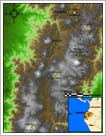
Climbing Ecuador's Volcanoes FAQ
Here is where you will find answers to some of your questions about this expedition. If you do not find what you need here, please contact us at info@bergadventures.com.
Choose the specific question to link to your answer
- How much mountaineering experience do I need for this expedition?
- How demanding is this expedition?
- Do you have guides to take someone back down should they become ill upon ascent and require descent?
- How much money do we need to bring?
- How can I improve my chances of acclimatizing once I arrive?
- What are some typical souvenirs from Ecuador?
- When is the best time to climb in Ecuador?
- Will we be staying in tents during the trip?
- What kind of currency is used in Ecuador?
- What is the food like on the trip?
- Should I bring snacks?
- What kind of weather should I expect?
- What kind of camera should I bring?
- Will my cell phone work in Ecuador?
- Can I recharge my electronics while on this trip?
- Can I store my luggage somewhere?
- Do you have access to radio communications for any emergency needs?
- Is Ecuador safe?
- When should I book my flight?
- Can I extend or shorten my trip?
- Are there any required vaccinations for Ecuador?
- 1. How much mountaineering experience do I need for this expedition?

- Cotopaxi and Chimborazo involve glacier climbing of easy to moderate difficulty. You will spend time walking with an ice axe, be familiar with self-arrests and learn the proper technique for walking on snow slopes up to 45 degrees. You will wear crampons during the ascent. If you have not been at altitude before, it is important to understand that you will need to pay close attention to your body’s ability to acclimatize. Your guides will help you make good decisions. You will gain valuable experience about dressing properly and navigating glaciers.
- 2. How demanding is this expedition?

- Cotopaxi and Chimborazo both require “alpine starts”, beginning in the early morning darkness. Summit days can be quite long, 12 to 14 hours on Cotopaxi and 13 to 16 hours on Chimborazo are common times. Since we will be leaving from huts, getting dressed and ready for the climb is quite easy. These climbs are all excellent introductions to roped team glacier travel and climbing skills for alpine climbs of moderate difficulty. You will have short sections of steep ice and snow, some movement over alpine rock, especially on Chimborazo. You will be roped for safe glacier travel as well as belayed for the more difficult sections of each climb.
- If you wish to join only the first part of our trip, Rucu Pichincha, Imbabura and Illiniza Norte, all trekking peaks, will be challenging due to the altitude, but they won’t require any special climbing gear. Good rain gear, warm layers, and hiking boots will be all that is necessary.
- We highly recommend you review the “Expedition Prep” section of our website, where you can find excellent travel and climbing resources and training tips.
- 3. Do you have guides to take someone back down should they become ill upon ascent and require descent?

- Our summit teams usually do not arrive on the summit at the same time. This is because we travel in smaller groups based on individual pace. There is no need to worry about “will I be the slowest”, or “will someone hold me back?”
- Due to our high guide ratio we will always have an extra guide available to help escort someone if they turn back before the summit. We adapt to the demands of each summit day differently, but you will have the support of experienced guides who know the route well throughout your climb.
- 4. How much money do we need to bring?

- Ecuador in general is quite inexpensive. You will not need to have much money on hand, but if you are in the habit of having drinks and buying souvenirs, for example, you will want to budget accordingly. We have traveled with people who have spent as little as US$150 for a few meals not included in our program, beverage and incidental expenses. The average is probably four times that. Major credit cards are accepted many places and ATMs are available in Quito.
- 5. How can I improve my chances of acclimatizing once I arrive?

- Once you arrive in Quito and have been transferred to your hotel, we suggest that you take a nap for a few hours or rest. Avoid alcohol. Drinking plenty of bottled water will also help. We encourage the use of Diamox as a preventative aid for symptoms of AMS (altitude sickness). Before taking any medications, talk with your physician to determine if this is appropriate for you.
- 6. What are some typical souvenirs from Ecuador?

- Ecuador is known for its vibrant and cultural markets. Travelers can purchase unique handicrafts and woven fabrics in llama or alpaca wool. We’ll explore these markets while in the city of Quito, Otavalo, and Baños to name a few.
- 7. When is the best time to climb in Ecuador?

- There are two climbing seasons in Ecuador, June to August and November to February. November to February is considered to be the best time for climbing. Cotopaxi can be climbed year round because it creates its own microclimate and has the most number of clear days of all the Ecuadorian mountains.
- 8. Will we be staying in tents during the trip?

- We do not use tents during this expedition. We will be lodging in hotels, historical haciendas, and comfortable mountain lodges and refugios (huts) at High Camp. You will need a moderately warm sleeping bag for the huts, but you will not need to bring a sleeping pad or Therm-a-Rest®.
- 9. What kind of currency is used in Ecuador?

- The official currency in Ecuador is US dollar. Bring plenty of small bills as Ecuador is not an expensive place. US $1, $5, $10 and $20 dollar bills are more commonly used. US $50 and $100 dollar bills are also accepted but not easy to break.
- 10. What is the food like on the trip?

- We will enjoy first-rate meals in fine restaurants and hotels along the way. The haciendas are especially known for great food. At the huts we will eat more modest but still nutritional foods such as potatoes, bread, soup, and pasta (with small portions of meat) prepared by a Berg Adventures cook. Throughout the trip, you will have access to various local fruits and enjoy them fresh or in delicious fruit juices.
- Vegetarian and other special dietary needs are available upon request.
- 11. Should I bring snacks?

- If you have special dietary needs, or a particular snack that you prefer to have with you at all times, go ahead and bring it along. However, it is not necessary to get carried away with quantity. You will have plenty of high quality, nutritious food, and excellent variety in you menu options every day.
- 12. What kind of weather should I expect?

- Quito can be hot at midday when the sun is brightest at that altitude. In the evening, temperatures are often cooler than most places in the U.S. We will experience the classic variable mountain weather: warm in direct sunlight and cool on cloudy days or in the evening. You will be adjusting your layers all throughout the climb and hike in Ecuador. Summit days are typically very cold, so again, plan to dress in comfortable layers for weather variations.
- 13. What kind of camera should I bring?

- There will be remarkable photo opportunities throughout your adventure in Ecuador of indigenous people and their colorful attire, volcanoes and the lush landscape, as well as great climbing shots of you and your teammates. Digital point-and-shoot cameras are a good choice because they are small and easy to keep handy. However, regardless of what camera you decide on, be sure that it is rugged enough to handle mountain conditions such as extreme temperatures, dust, and precipitation.
- It is also important to know how to use your camera. Get familiar with the equipment before your trip start date in order to avoid disappointing results.
- SLR cameras with interchangeable lenses are worth the extra weight and expense if you are into photography. Do not hesitate to bring yours. Even if you do not climb with it, you will enjoy using it as we drive through Ecuador’s beautiful landscape.
- If you prefer not to invest in a camera, do not underestimate the ability of your mobile (iPhone) camera. Not only does this device do the job, but you may easily share your images in real-time with friends and family or through social media.
- Video cameras are also nice. In addition to capturing moving images they record the sounds, music and conversations of your adventure.
- 14. Will my cell phone work in Ecuador?

- Yes, but be sure to check about the rates with your service provider before you leave. It may be cheaper to use local phone services in Ecuador or to use the Internet.
- 15. Can I recharge my electronics while on this trip?

- Yes! All of the hotels, Haciendas and most of the mountain lodges will have electrical outlets. The electric outlet allows up to 240 volts.
- 16. Can I store my luggage somewhere?

- Your trip starts and ends in Quito. If you wish, you may store some of your travel items at the J.W. Marriott hotel there at no additional cost.
- 17. Do you have access to radio communications for any emergency needs?

- We will have radios on the mountain and we will always have a satellite phone with the group for emergency communication.
- 18. Is Ecuador safe?

- Ecuador is like many other countries around the world today and will require the use of common sense i.e., don’t flash any valuables. As in any other place, theft is a possibility. It is wise to always keep a close eye on your gear and stay with the group at all times.
- 19. When should I book my flight?

- One of the advantages to climbing in Ecuador is that Quito’s International Airport is serviced by various airlines. There may be more flexibility available to you, i.e. flights through Houston on United Airlines and though Miami on American Airlines. Please call us if you would like suggestions or assistance with booking your flight.
- 20. Can I extend or shorten my trip?

- Over the course of two exciting weeks, we will embark on an unforgettable journey to some of our most beloved sites in Ecuador and up and around its spectacular peaks. However, if you’d like to shorten your trip, we can accommodate your schedule. On the flip side, if two weeks are not enough, we do have extensions available to the Galapagos Islands and the Amazon Rainforest just to name a few!
- 21. Are there any required vaccinations for Ecuador?

- Unless you enter Ecuador from a country where yellow fever is a risk, vaccinations are not required when travelling to Ecuador. However we do advise you that the following vaccinations, Tetanus, Yellow Fever, Typhoid, Hepatitis A&B, and Malaria prophylaxis are considered if you plan to visit the Amazon. Please be sure to discuss these vaccinations with your local physician before visiting Ecuador.
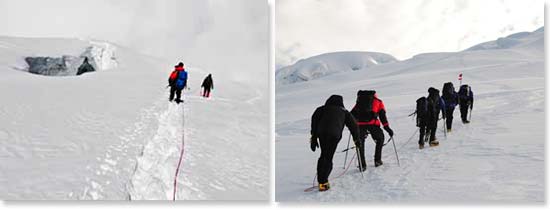
Glacier travel
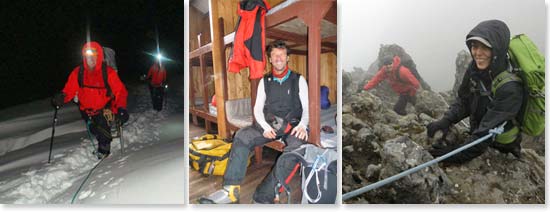
Left: Alpine Start; Center: Leaving from the huts, makes it easier
Right: Good rain gear will be required for our trekking peaks.
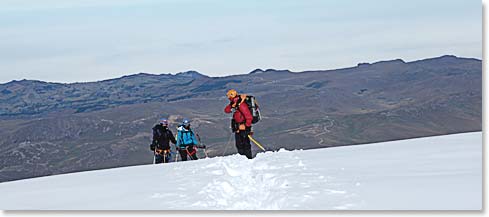
Small teams, full support
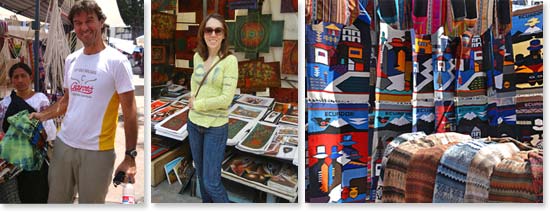
Shopping at the local markets

A few of the fabulous haciendas where we stay.
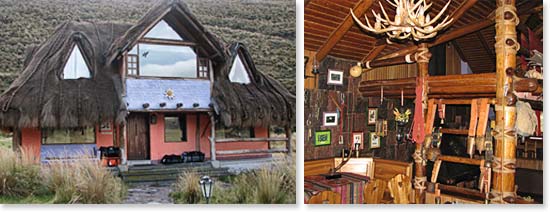
Our mountain lodge

Imagine tasting the culture after a long day of climbing.
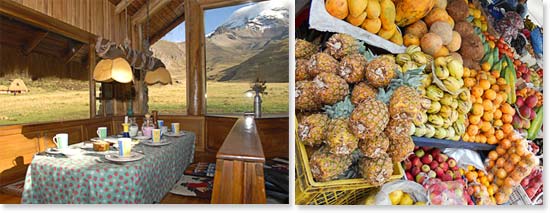
Left: Breakfast with beautiful views of Chimborazo Right: Fresh fruits and juices everywhere
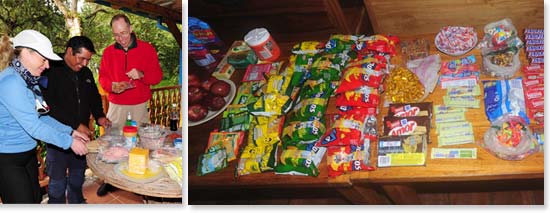
Preparing our pack lunch – lots of choices
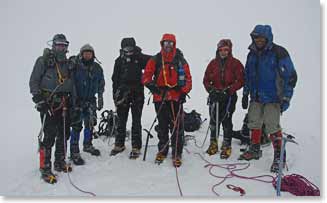
It can be very cold! Plan for weather changes and layering.
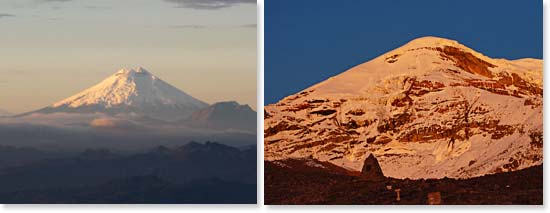
There are photo opportunities everywhere you look in Ecuador
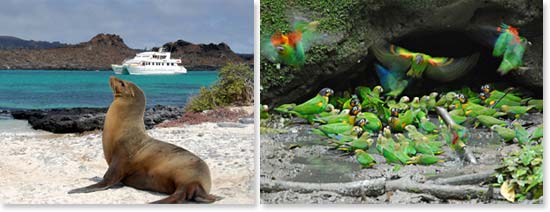
Left: Galapagos; Right: Amazon Jungle


